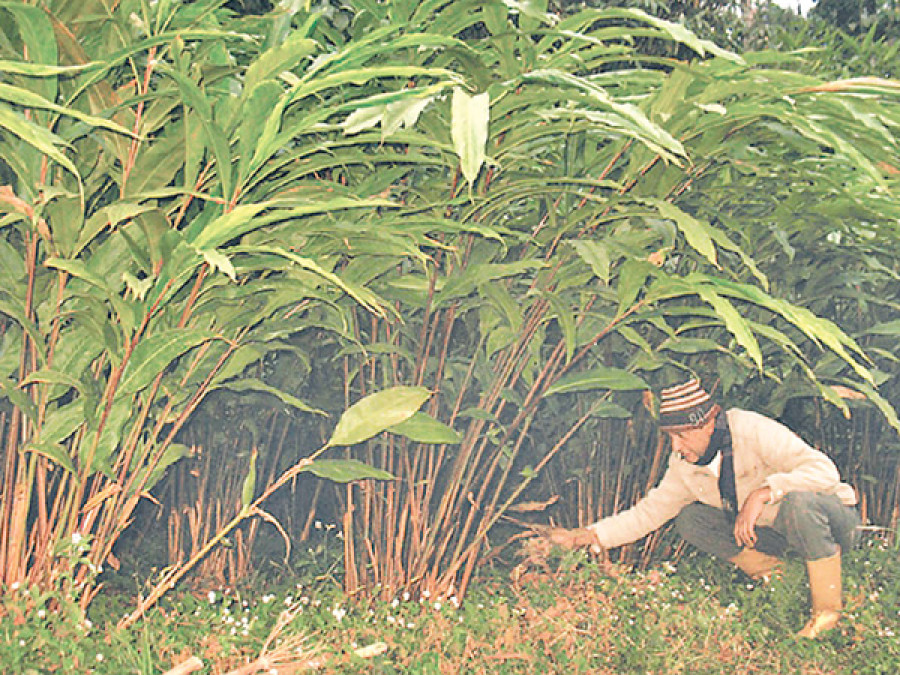Opinion
A touch of spice
Farmers blindly switching to growing cardamom should be told about the potential risks
Sony KC
Cash crop farmers in Ilam district have been working hard to revive centuries-old cardamom farms for a decade now. The production of the spice plant had dropped sharply due to disease in the past. In the process of revival, old cardamom species have been replaced by a new type called Salakpure cardamom. This species originated in Salakpur village located in Jirmale village development committee (VDC), Ilam. Though the revival process requires tremendous effort and patience, high returns have encouraged farmers to face any challenge or substitute any crop for cardamom.
The Nepal Centre for Contemporary Research conducted a quantitative survey of 513 households in Jirmale VDC from November 16 to December 3, 2015 under a project entitled Feminisation of Agriculture, Transition and Rural Employment.
The project is led by the University of Bern, Switzerland and partnered by institutions in Nepal, Rwanda, Laos and Bolivia. One of the aims of the survey was to understand the issue of agricultural transition from subsistence to commercial farming systems and the employment situation of farmers. I took part in the survey, which is a part of my PhD research, along with a group of enumerators. In the process of analysing the bulk of the data we collected, a few issues that came from the farmers may require meticulous attention in the current agricultural-transition discourse.
Issues to ponder
First, given that a majority of the households surveyed consisted of self-employed farmers, they seemed to be satisfied with the transition from subsistence to commercial agriculture. Commercial cardamom farming, in particular, has become a major source of income for many households. During an informal conversation, a farmer from Rambhyang village of Jirmale said, “In the next five years, you will see only cardamom fields in this village. The existing rice and vegetables fields will be gone.” Another farmer from Salakpur stated, “If a crop harvested in small quantities can feed the whole family, why not cultivate it?”
Second, the value of subsistence crops has declined even for farmers with big landholdings. My intrinsic liking for travelling has always been associated with getting to eat local organic food and vegetables. Surprisingly, during the field trip, I found that the villages currently producing cardamom and other cash crops had stopped growing vegetables. People purchased rice, vegetables and oil for consumption. A farmer with a lot of land in Salakpur stated, “I have recently planted cardamom in my vegetable garden. Planting cardamom and vegetables is as different as sky and earth.”
Another farmer with a small piece of land less than 1 ropani in area added,
“I use all my land for cardamom cultivation. I would rather buy vegetables with
the money I get by selling cardamom.”
With a touch of greed and selfish motive in mind, I shared my concern about not getting to enjoy locally grown green vegetables. An elderly farmer said, “In our time, we used to grow both cardamom and green vegetables. The young generation is going after money now.” The assumption is that, in about a decade, the farmlands in the villages will only have cardamom, the main reason being good returns from the spice plant.
A risky transition
This notion of a transition from subsistence to commercial farming of cardamom struck me, though I respect the farmers’ idea of earning more to improve their living standards. Since the fieldwork, I have been wondering whether our government, which has listed cardamom as one of the top export crops, is aware of this transition. The transition has been rapid because, first, people are completely giving up subsistence farming attracted by the good returns from commercial farming. Second, the idea of sustainable cardamom farming or any other cash crop is not part of our national or local agricultural agenda. Neither is it included in the farmers’ agenda. Third, and this is based on my prior findings in other VDCs of Ilam, commercial cardamom farming had completely disappeared due to disease in the past one decade. And as a result, farmers had suffered a severe impact on their livelihoods. Somewhere, my lenses see that the balance does not seem right.
As a researcher, I do not stress that farmers should maintain a balance between commercial and subsistence farming. Neither do I insist that the government enforce a fine balance between the two. I agree that growing cash crops has increased the income of households, provided opportunities for wage work, contributed to food security and boosted export revenues. But this simply raises the question of the risk farmers have taken by switching from subsistence to commercial cash crop farming. As an elderly farmer said, “Cardamom farming will not last long, and I can feel it. A few decades ago, the production from 1 ropani of land was double of what they are growing now.”
If cardamom production does not last long in Jirmale like in other VDCs of Ilam, the farmers who have worked so hard to cultivate cardamom and boost its exports will suffer. There is a chance that crops will fail, and there is evidence of a decline in cardamom production. The current Agriculture Development Strategy (ADS) contains a provision for distributing new cardamom saplings to farmers who have lost their crops to disease. My only concern is whether the provision can be moulded into sustainable cardamom farming, stressing the fact that it is still Nepal’s top priority crop.
Salakpur and Rambhyang villages of Jirmale are high potential areas for commercial cardamom production. Farmers are blindly cultivating cardamom for export. I feel that they are less aware of the sustainability issue. I see a need for an alliance of stakeholders, a good partnership between institutions such as cooperatives, local agriculture offices, research institutions and development agencies. A well-formed alliance can help sustain cash crop farming and raise awareness among farmers regarding crops, particularly cash crops, in transition. Whether it is a transition from “greens to black gold” crops, farmer protection should be the major agenda of our agricultural discourse. We know that without farmers, the country’s economy will be paralysed.
KC is a PhD candidate of feminisation of agriculture transition and rural employment, Kathmandu University




 17.12°C Kathmandu
17.12°C Kathmandu










